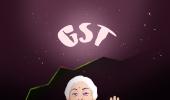With concern on food inflation ebbing with the monsoon progressing well, the Reserve Bank of India (RBI) is warming up to the idea of a change in stance to “neutral” from “withdrawal of accommodation”, according to economists.

In his speech on Thursday during the annual event of the Federation of Indian Chambers of Commerce and Industry-Indian Banks’ Association, RBI Governor Shaktikanta Das said: “The balance between inflation and growth is well-poised.”
He also sounded optimistic on food inflation because of a good monsoon, and said the food inflation outlook could become more favourable over the course of the year.
Aditi Nayar, chief economist, ICRA, said: “Based on the evolving outlook for growth and inflation, our sense is that the stance could be changed in the October or December 2024 policy reviews.”
The six-member Monetary Policy Committee (MPC) of the central bank has kept the stance unchanged for over two years -- since the rate-increasing cycle started.
Even if the RBI paused rate increases in February 2023, it continued with the “withdrawal of accommodation” stance.
Between May 2022 and February 2023, the policy repo rate was increased by 250 basis points to 6.5 per cent.
“I tend to believe the RBI is satisfied with the trajectory of both growth and inflation as of now.
"Therefore, one can assume the central bank may not be averse to a change in stance or rate action in future, depending on the data that comes in on inflation in particular,” said Madan Sabnavis, chief economist, Bank of Baroda.
He said at the earliest a rate cut could be in December, when the complete picture on inflation is known more in terms of being stable on a durable basis.
Food inflation has been a handicap for the RBI because sticky prices, coupled with sudden shocks, have made the last mile of disinflation slow.
Food inflation has a 46 per cent weighting in headline inflation.
The headline inflation rate moderated to 3.5 per cent in July 2024 from 5.1 per cent in June 2024. Food inflation (Y-o-Y) declined to 5.1 per cent in July from 8.4 per cent in June.
Economists say there has been a board-based decline in food prices in August also.
“The governor sounded more positive on the inflation outlook with the spatial distribution of the monsoon remaining broadly positive.
"Daily food prices in August show a broad-based decline (on a month-on-month basis), spread across vegetables, pulses and cereals.
"We estimate August consumer price index rate at 3.4 per cent, after building in a decline in month-on-month food prices,” said Gaura Sen Gupta, chief economist with IDFC First Bank.
While a change in stance is expected soon, views differ if the RBI will both cut rates and change the stance in the same policy review or a rate cut will follow a change in stance.
Sen Gupta expects the rate cut cycle to start in either October or December and that a change in stance and policy rate cut to take place in the same policy. “This will allow the RBI to retain policy flexibility by not giving a forward guidance,” she said.
Nayar, however, sees first a change in stance, followed by a rate cut.
“The first rate cut could follow in the policy meeting subsequent to the stance change.
"We foresee a shallow cutting cycle of two rate cuts of 25 basis points each,” Nayar said.
Shreya Sodhani, regional economist, Barclays, agrees the outlook for food inflation is to trend lower on average for the rest of the year.
“Our analysis suggests that the period of persistent food inflation is likely over and while seasonal pressures may re-emerge in October-November, these will be relatively small in magnitude (compared with the summer uptick).
"In fact, we expect inflation in Q2 and full year FY25 (4.3 per cent) will likely be lower than the RBI’s forecasts (4.5 per cent),” Sodhani said.
The monetary policy stance is likely to be maintained till the December meeting, which is the opportune time to cut rate, and also “in line with the MPC’s preference of avoiding giving specific forward guidance”, she said.
All eyes are now on August inflation data, which will be published next week and will be considered for the next monetary policy review scheduled for October 7-9.
The October policy will also see three new external members of the rate-setting panel. Jayanth Varma and Ashima Goyal, the two external members of the MPC, voted for a rate cut along with a change in stance in the last few meetings, citing higher real interest rates.












 © 2025
© 2025